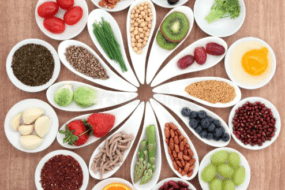
Introduction: The Importance of a Healthy Diet
Eating well is more than just a trend; it’s a lifestyle choice that can transform your health. The kitchen is the heart of this journey, filled with potential and possibilities. When you stock it with the right ingredients, you’re not just preparing meals—you’re nourishing your body and fueling your life.
Navigating the world of nutrition can feel overwhelming at times. With so many options available, how do you choose what truly benefits your health? This guide will help simplify things by highlighting essential kitchen staples that support a balanced diet. From whole grains to fresh produce and lean proteins, let’s explore how these nutritious foods can become the foundation for delicious meals that promote wellness every day!
Eating well is more than just a trend; it’s a lifestyle. Nourishing your body with wholesome foods can boost your mood, enhance your energy levels, and improve overall health. But how do you make sure you’re always prepared to eat right? It starts in the kitchen. When you stock up on healthy staples, cooking becomes easier and more enjoyable.
Imagine opening your pantry and finding vibrant grains, fresh spices, and nutrient-packed legumes ready for use. Each ingredient has the potential to transform simple meals into nourishing powerhouses that fuel every part of your day. With the right essentials at hand, you’ll be inspired to whip up delicious dishes without relying on processed options or takeout.
Let’s explore those essential kitchen staples that not only make meal prep a breeze but also support a healthier lifestyle. Get ready to elevate your culinary game while nurturing your body from within!
Whole Grains: The Foundation of a Nutritious Meal
Whole grains are an essential part of any healthy diet. They provide vital nutrients and fiber that our bodies need to function optimally.
Think about options like quinoa, brown rice, barley, or whole wheat pasta. These foods not only fill you up but also offer sustained energy throughout the day. Unlike their refined counterparts, whole grains retain their bran and germ, which means they’re richer in vitamins and minerals.
Incorporating these grains into meals can be simple. Swap out white rice for quinoa in your stir-fry or choose whole grain bread for your sandwiches. Each small change contributes to a more balanced plate.
Additionally, whole grains can help regulate digestion and keep cholesterol levels in check. So next time you’re planning your meals, consider making them the star of the show. Your body will thank you!
Fresh Produce: Incorporating Fruits and Vegetables into Your Diet
Fruits and vegetables are vibrant allies in your quest for a healthier lifestyle. They provide essential vitamins, minerals, and antioxidants that boost immunity and promote overall well-being.
Start by making these colorful foods the stars of your meals. A hearty salad with mixed greens, cherry tomatoes, cucumbers, and avocados can be both filling and refreshing.
Smoothies offer another delightful way to pack in nutrients. Blend spinach or kale with bananas, berries, and yogurt for a delicious drink that’s perfect any time of day.
Don’t shy away from roasting vegetables either! Tossing carrots, bell peppers, or Brussels sprouts with olive oil and herbs brings out their natural sweetness while creating a satisfying side dish.
Explore seasonal produce at local farmers’ markets; it’s often fresher than store-bought options. By incorporating an array of fruits and veggies into your daily routine, you’ll not only enhance flavor but also nourish your body effectively.
Lean Proteins: Choosing the Best Sources for Optimal Health
Lean proteins play a crucial role in maintaining a balanced diet. They help repair tissues, support muscle growth, and keep you feeling full longer.
When considering your options, poultry is often a go-to choice. Skinless chicken breast or turkey offers high protein content without excessive fat. Fish is another excellent alternative—salmon and trout are rich in omega-3 fatty acids that benefit heart health.
Don’t overlook plant-based sources either. Beans, lentils, and chickpeas provide not only protein but also fiber for digestive health. Tofu and tempeh are versatile soy products that can easily be incorporated into various dishes.
Eggs stand out as another fantastic source of lean protein packed with essential nutrients. Opting for low-fat dairy like Greek yogurt can offer additional benefits while keeping calories in check.
Choosing the right lean proteins is vital for energy levels and overall wellness; it’s about finding what works best for your lifestyle.
Healthy Fats: Why They are Essential and How to Incorporate Them into Your Diet
Healthy fats are crucial for a balanced diet. They support brain function, absorb vitamins, and provide energy.
Incorporating these fats into your meals is simpler than you might think. Start with avocados; they add creaminess to salads and sandwiches while delivering heart-healthy monounsaturated fats.
Nuts and seeds also deserve a spot in your pantry. A handful of almonds or chia seeds can elevate smoothies or yogurt bowls, turning them into nutritional powerhouses.
Olive oil should be your go-to cooking fat. It’s perfect for sautéing vegetables or as a base for salad dressings. Drizzling it over finished dishes enhances flavor too.
Don’t overlook fatty fish like salmon or mackerel either. Rich in omega-3s, they promote heart health and contribute to overall well-being.
Remember that balance is key when integrating healthy fats into your diet; moderation ensures you reap their benefits without excess calories.
Plant-Based Alternatives: Exploring Vegan and Vegetarian Options
Plant-based diets are gaining traction for good reason. They offer a wealth of benefits, both for personal health and the environment. Exploring vegan and vegetarian options can open up a vibrant world of flavors.
Legumes like lentils and chickpeas pack a protein punch while providing fiber. These versatile foods can be transformed into hearty soups or flavorful spreads.
Tofu and tempeh are excellent meat substitutes. Their ability to absorb flavors makes them perfect for various cuisines—from stir-fries to tacos.
Don’t forget about whole grains! Quinoa, farro, and brown rice serve as delightful bases for salads or bowls.
Dairy alternatives have come a long way too—almond milk, cashew cheese, or coconut yogurt make it easy to ditch animal products without sacrificing taste.
Experimenting with these options encourages creativity in the kitchen while promoting overall wellness.
Plant-based diets are gaining popularity for good reason. They offer a wealth of health benefits and can be incredibly satisfying. Exploring vegan and vegetarian options opens up a world of flavors, textures, and nutrients.
Incorporating plant-based foods into your meals doesn’t mean sacrificing taste or satisfaction. Lentils, chickpeas, and quinoa serve as excellent protein sources while adding variety to your plate. These ingredients can be used in salads, soups, or even made into hearty veggie burgers.
Don’t forget about the power of leafy greens! Kale, spinach, and Swiss chard are nutrient-dense choices that can elevate any dish. Toss them into smoothies for an easy boost or sauté them with garlic as a delicious side.
Fruits also play a vital role in plant-based eating. Berries add sweetness to breakfast oatmeal while bananas make great natural sweeteners in baked goods. Their vibrant colors not only please the eye but pack essential vitamins too.
Dairy alternatives have come a long way as well. Almond milk, coconut yogurt, and cashew cheese provide creamy textures without animal products. Experimenting with these substitutes can lead you to discover new favorites.
Whether you’re fully committed to veganism or simply looking to reduce meat intake occasionally, there is no shortage of delicious options available today. Embrace this journey toward nourishing your body by exploring all the versatile ways plant-based foods fit into your meals—your taste buds will thank you!
Reading Labels and Avoiding Unhealthy Add
When it comes to maintaining a healthy diet, knowledge is power. One of the most essential skills you can develop is reading food labels. This practice allows you to make informed decisions about what you’re putting into your body.
Start by checking the ingredient list. The shorter it is, the better—especially if whole foods are at the top of that list. Look out for hidden sugars and unhealthy additives that can sneak their way into processed items. Ingredients like high fructose corn syrup or artificial flavors may seem harmless but can undermine your health goals.
Next, pay attention to serving sizes. Sometimes what looks like a single portion could actually be two or three servings packed in one container. Understanding this helps manage calorie intake and keeps portions realistic.
Don’t forget about nutritional value either! Focus on products rich in fiber, protein, vitamins, and minerals while keeping an eye on sodium levels too—a common culprit in many packaged foods.
By becoming label-savvy and staying vigilant about unhealthy additives, you’ll not only elevate your cooking game but also help nourish your body effectively. Your kitchen should be stocked with choices that fuel rather than deplete you as you embrace healthier living habits moving forward.






















